As he stands admiring his front-yard rain garden on a recent fall morning, Steve Severin is darn near giddy.
“Isn’t it great?” he asks. “My yard before was all grass. I’m very, very happy.”
A copper “rain chain” that looks like a series of tulip blossoms strung together hangs down from a corner of his roof. At the bottom of the chain is a hammered copper bowl nestled among river rock ready to catch the rain that drips down. The rocks lead downhill to a rain garden planted with small grasses and shrubs. On the other side of the walkway to his front porch is a second, smaller rain garden.
In addition to the rain chain, PVC pipe wraps around Severin’s Ballard-neighorhood house and underground, draining all of the water that hits his 1,800-square-foot roof into the rain gardens.
In an average year in Seattle, Severin’s rain gardens will capture and treat about 41,500 gallons of water that would otherwise have become polluted runoff.
“It looks beautiful,” he said, “but it’s also functional.”
There’s an added bonus: the $5,500 rain garden was paid for by Seattle Public Utilities’ RainWise program, which reimburses residents in certain neighborhoods for installations of green stormwater solutions.
While stormwater experts agree that rain gardens and similar strategies are essential tools for cleaning up and shrinking the amount of filthy runoff that pours from our roadways and roofs, the technologies have been slow to take off in most places. Property owners often don’t understand how big of a problem stormwater is, or they fear that rain gardens won’t work because of a couple of well-publicized problem gardens in the past.
But new public-private partnerships are cropping up in Seattle to help residents learn more about rain gardens and take advantage of programs like RainWise. Nonprofit groups including Stewardship Partners, Sustainable Seattle and Sustainable Ballard — all of whom promote environmentally friendly practices — are helping in the effort.
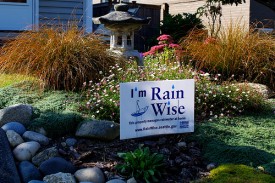
“As (nonprofits) talk to people and energize individuals, that is how the word is going to spread,” said Susan Harper, outreach coordinator for RainWise. “They are getting grants to do outreach on our behalf, and working in tandem with us. It’s an opportunity for government to hold hands with nonprofits.”
She said it’s beneficial for nonprofits to work as liaisons with the public. They’re able to communicate the message that programs like RainWise are a public resource that people should take advantage of.
Stewardship Partners is promoting a campaign called 12,000 Rain Gardens that aims to expand the use of green stormwater infrastructure in the Puget Sound area. Their idea for helping RainWise was to hire someone who would both help residents navigate the program’s somewhat lengthy application process and recruit groups of neighbors to participate in RainWise. Stewardship Partners wants to create “clusters” of stormwater projects, rather than individual installations scattered about.
“These clusters were kind of magic,” said Aaron Clark, program manager of the 12,000 Rain Gardens program. “When people did it together, they talked about it more.”
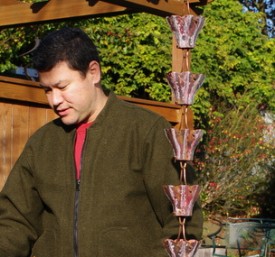
Often times “champions” emerge from the groups, people who encourage others to install these projects, as well as answer their questions and concerns. The clusters, it seems, could create their own momentum in support of green stormwater solutions.
The strategy has worked well elsewhere in Seattle in recent years, including the North Delridge neighborhood of West Seattle and Georgetown. Puyallup (see more from the city and landscaper Rain Dog Designs), Everett, Burien, and Olympia also have successfully built clustered rain gardens. Outside of the Puget Sound region, Portland has multiple cluster projects.
Stewardship Partners hired Cari Simson, who led the Georgetown cluster project, as well as an effort to build an industrial rain garden at a machinery business near the Duwamish River, to work on the project. Simson helped get Severin and another Ballard resident, Beth Humphreys, on board.
Humphreys wanted to spiff up her front yard after years of neglect, and the idea of incorporating a rain garden appealed to her. She went to the RainWise website, but found it overwhelming. So she attended one of Seattle Public Utilities’ RainWise meetings, and met Simson, who was scouting out residents to assist. Simson and Humphreys teamed up, and hosted a meeting at Humphreys’ house to explain the program to other neighbors. Together, the group interviewed contractors and now three residents on Humphreys’ street have installed rain gardens, and a fourth project is in the works.
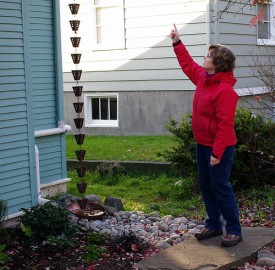
Humphreys’ rain garden measures 85 square feet, but is able to absorb the runoff from her entire 1,841-square-foot roof. It, too, features a rain chain as well as deer fern and red twig dogwood. The landscaper, Fasoldt Gardens, was also able to keep and incorporate some mature trees already in the yard.
The RainWise program has recently expanded and is currently offered in select neighborhoods: Ballard, Delridge, and the Northeast Seattle neighborhoods North Union Bay and Windermere. All of these areas have problems with combined sewer overflows, or CSOs, that can dump raw sewage into local lakes and Puget Sound during heavy storms. The city is required to reduce the incidence of overflows by making improvements to the infrastructure, including green stormwater projects.
There are now 180 RainWise installations in Ballard, Harper said. “We’re meeting our targets.”
The RainWise rebate covered the $5,500 rain garden for Humphreys, and she opted to pay out of pocket for some fancier paving stones and design work. The average rain garden, Clark said, costs around $4,000 to $5,000 to install.
“Our role as RainWise is setting protocols and standards so when it’s being implemented, it’s being done properly,” Harper said. “Our role is traffic controller and rebate provider and being accountable for those dollars.”
One challenge to getting more widespread participation in the program is the fact that homeowners are reimbursed by the city after the work is done. Some contractors will wait to bill residents once they have their rebate. Because many residents can’t foot the thousands of dollars up front, Stewardship Partners wants to create a revolving fund offering rain garden loans to homeowners who would repay it with their rebate, Clark said.
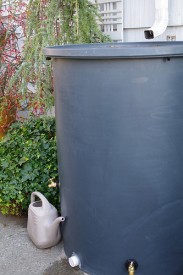
Not all properties are well suited to rain gardens — but that doesn’t mean they can’t participate in RainWise. Theresa Olsen, a neighbor of the Severin’s, is an avid gardener, but her property is heavily landscaped and includes a lot of pathways and hard surfaces. Her green stormwater solution? Three 200-gallon cisterns.
“I use a lot of water and my water bill is very expensive,” Olsen said. She was thrilled to discover that the cisterns would work for her. The giant containers are tucked along her house, and behind a fence in one spot. As with the other homes, the green infrastructure captures the water from her entire roof. After getting the cisterns installed this fall, they filled with water in just two days.
“I’m going to spend less for water,” Olsen said. “I’m so excited about that. Free water!”
That’s another important feature of RainWise and similar programs, supporters of the efforts say: They help the residents of the Northwest shift their perceptions about stormwater runoff and rainfall.
“Instead of treating it as a problem,” says Simson, “It’s a resource.”
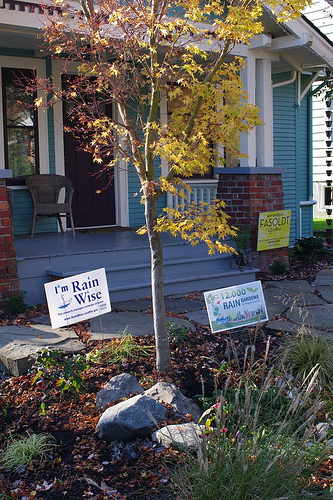

Comments are closed.